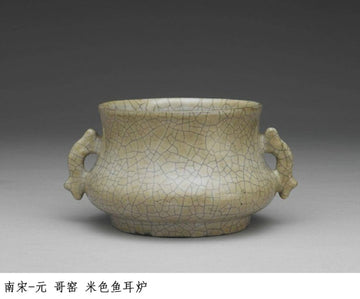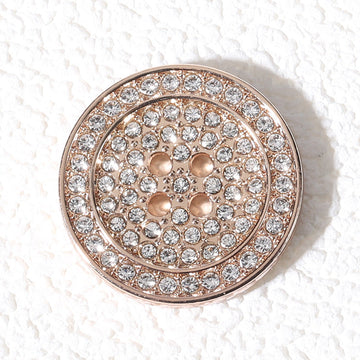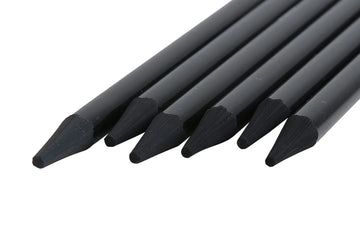
Introduction
Among the "Five Great Kilns" of China’s Song Dynasty (960–1279 CE)—Ru, Guan, Jun, Ding, and Ge—the Ge Kiln (哥窑) stands out as the most mysterious. Celebrated for its mesmerizing "golden threads with iron lines" (金丝铁线) glaze, Ge ware embodies a paradoxical blend of deliberate craftsmanship and natural beauty. Yet, despite its fame, the kiln’s origins remain hotly debated, its artifacts scattered across museums, and its true production site still unconfirmed. This article explores Ge Kiln’s historical records, distinctive features, scholarly controversies, and enduring cultural legacy.
Historical Background

Literary Records and Myths
The earliest mention of Ge Kiln appears in the Ming Dynasty (1368–1644) text Gegu Yaolun (格古要论), which attributes its creation to Zhang Sheng Yi (章生一), a legendary potter from Longquan, Zhejiang. According to folklore, Zhang and his brother Zhang Sheng Er (章生二) operated competing kilns—Ge ("Elder Brother" Kiln) and Di ("Younger Brother" Kiln)—with Ge’s wares prized for their crackled glaze.
However, historical accuracy is murky. Some scholars argue that "Ge Kiln" might refer to Southern Song (1127–1279) **official kilns** in Hangzhou, producing ware for the imperial court. The confusion stems from overlapping terms like *Guan* (官, "official") and *Ge* (哥, "brother"), as well as similarities between Ge and Guan Kiln wares.
The Archaeological Mystery
No definitive Ge Kiln site has been identified. Two competing theories persist:
1. Longquan Theory: Black-bodied celadons with crackled glazes, excavated in Longquan, may represent "Ge-type" ware.
2. Hangzhou Theory: Fragments from Hangzhou’s **Tiger Cave Kiln** (老虎洞窑址, Yuan Dynasty layer) resemble later Ge-style imitations, suggesting the original kiln was nearby.
Without concrete evidence, Ge Kiln remains a "ceramic ghost"—revered in texts but elusive in the ground.
Distinctive Features of Ge Ware
1. The Iconic Crackle Patterns
Ge Kiln’s signature is its intentional glaze cracks, achieved through a mismatch in the thermal expansion of clay and glaze. Artisans enhanced these cracks post-firing:
- "Iron wires" (铁线): Thick, dark fissures stained with ink or ochre.
- "Golden threads" (金丝): Fine, golden-yellow secondary cracks, possibly dyed with plant extracts.

2. Glaze and Color
Ge ware typically has a **thick, opaque glaze** in soft hues:
- Gray-blue (粉青)
- Milky white (米白)
- Pale green (灰青)
The glaze often pools thinly at the rim, revealing the dark "iron" body beneath—a feature called **"purple mouth" (紫口)**.
3. Clay Body and Form
- Dark clay: High iron content gives the unglazed foot a burnt umber tone ("iron foot," 铁足).
- Classic shapes: Bulbous vases, *guan* jars, and tripod incense burners, often modeled after ancient bronzes.
Scholarly Debates: What Is Ge Ware?
1. "Classic" Ge Kiln (传世哥窑)
The label applies to crackled-glaze pieces in museums (e.g., Beijing’s Palace Museum), traditionally dated to the Song Dynasty. However, recent studies suggest some may be Yuan (1271–1368) or Ming (1368–1644) imitations.
2. Longquan Black Celadon (龙泉黑胎青瓷)
Excavations in Longquan revealed black-bodied, crackled celadons. Some scholars insist these are the "true" Ge ware, while others argue they’re a distinct type.
3. Later Replicas
From the Yuan onward, kilns like Jingdezhen mimicked Ge’s crackle effects using different techniques. Ming-era Miscellaneous Notes on the Orange Studio (遵生八笺) even praised fake Ge ware as "indistinguishable from antiques."
Cultural Legacy and Influence
1. The Philosophy of Imperfection
Ge Kiln’s cracks were embraced by Chinese literati as a metaphor for the beauty of transience—a concept later echoed in Japan’s *wabi-sabi* aesthetics.
2. Collector’s Obsession
Ge ware became a status symbol among Ming-Qing elites. Emperor Qianlong (1711–1799) composed poems praising Ge Kiln vases, now housed in the Taipei Palace Museum.
3. Modern Mystique*
In 2017, a Song-style Ge Kiln vase (later identified as Ming) sold for $38 million at a Hong Kong auction, underscoring its enduring allure.
Conclusion
Ge Kiln’s legacy lies in its contradictions: a kiln shrouded in myth yet celebrated for its artistry, a "flawed" glaze deemed priceless, and a cultural icon that transcends time. While archaeologists continue to hunt for its origins, the **"golden threads and iron lines"** endure as a testament to the Song Dynasty’s unparalleled ceramic genius.
As the debate persists, perhaps the mystery is part of its magic—an eternal enigma, frozen in crackled glaze.
References
- Chinese Ceramics: A New Standard Guide (He Li)
- Song Dynasty Ceramics (Rose Kerr)
- Palace Museum (Beijing) Catalogs on Ge Ware



